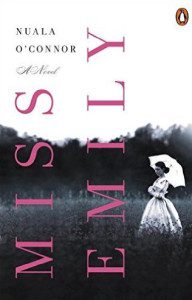
“You speak kindly of seeing me. Could it please your convenience to come so far as Amherst I should be very glad, but I do not cross my Father’s ground to any House or town.” — Emily Dickinson from Selected Letters
The above quote may as well be a directive to Emily Dickinson’s readers. Do you wish to know her? Very well, travel to where she dwells. Get inside her mind. See what she sees. Go to Amherst. Go to her Father’s house. She’ll gladly meet you there. But don’t expect her to cross any thresholds for you.
Crossing the threshold is the task that Nuala O’Connor takes up in her new book, Miss Emily. She meets Dickinson in her own space, at the Homestead, and imagines a friendship between the great poet and her Irish maid, Ada. Chapter by chapter, O’Connor alternates between the two women’s points of view, examining their interior and exterior lives, how they see one another, and their interactions with the world around them. This is no small challenge with any character in a piece of literature, let alone a fictionalized account of a famous poet.
But I’m getting ahead of myself. Before I get to Dickinson and what we can and cannot know about her, let me start with Ada.
Ada’s story drives Miss Emily—her day-to-day work, her falling in love, her experience as an immigrant and, eventually, her coping with a horrible crime. When I began reading the book, I worried that I’d be so drawn to Dickinson’s chapters that I would lose interest in Ada’s. But I needn’t have worried. Through Ada, 1800s Massachusetts comes to life, awash in rich period details and scenery, complete with a trip to the circus and lugging chamber pots up and down stairs. New to everything around her, Ada acts as the reader’s proxy as she enters the Homestead and discovers the Dickinson family. But she’s no mere observer. O’Connor does a beautiful job giving Ada a role as witness to Emily Dickinson’s life without relegating her to the sidelines.
One way that O’Connor masters this balance is by making Ada’s chapters as linguistically alive as Dickinson’s. They hum with Irish sayings and their own poetic cadence, even sometimes becoming a reflection of familiar Dickinson themes. Ada’s observations on nature, loneliness and hope contain echoes of Dickinson’s poetry—while remaining distinct to her own narration. This is one of the book’s great strengths, a sort of mixing and matching of language and perspective. Both women experience feelings of being stuck within themselves and their circumstances, and both use language as a way to escape. Whether it’s Ada singing comforting songs or Dickinson retreating to her room to write, each woman finds solace in the sounds of words. While their chapters clearly belong to one narrator or the other, there’s an overlap in viewpoints that raises fascinating ideas about where inspiration comes from, how shared experiences are translated into language, and the influence of day-to-day interactions on a poet’s work.

Which brings me to Dickinson. There’s no question that Dickinson looms large as a persona. Agoraphobic. Shrouded in white. A recluse. O’Connor wisely doesn’t fight against the familiar persona—nor does she overly explain Dickinson’s extreme need for solitude. Instead, with a light and lyrical touch, O’Connor traces Dickinson’s meandering thoughts, the pull she feels about finding the energy to write and her fleeting desire to be of the world. It’s a sympathetic rendering of a complicated mind that follows key moments in Dickinson’s life, including her decision to wear all white.
But it’s not all complication. O’Connor folds Dickinson’s poetic self into a portrayal that includes her love of baking, her offbeat sense of humor, and her fierce loyalty as a friend—both to Ada and to her sister-in-law, Sue. Sue and Dickinson’s friendship is one that many Dickinson scholars have puzzled over—and I won’t ruin any surprises in Miss Emily by saying how O’Connor handles the relationship. But I will say that the Dickinson who arises from the story is the type of friend you’d want in your life. She lowers baskets of gingerbread from her room to children waiting on the ground. She sneaks sweets from the kitchen. She helps people in times of trouble.
And this where I found myself giving pause. Would I really want Emily Dickinson as a friend? There’s no question that I would want to meet her. She’s certainly one of the top three people I’d invite to a dinner party (not that she’d attend). But, to be her friend?
From her poetry and letters, Dickinson gives the impression of a person who is intense, possessive, and cryptic. In one of her letters, answering a request to see an image of her, Dickinson replies: “I had no portrait, now, but am small, like the Wren, and my Hair is bold, like the Chestnut Bur—and my eyes, like a Sherry in the Glass, that the Guest leaves.” She communicates with winks and nods and puzzles. And while there are many moments of good humor and kindness in her writings, my overall sense is that Dickinson would probably exasperate me as a person, a notion that dogged me as I read Miss Emily. I found myself thinking, Is this portrayal of Emily Dickinson difficult enough for my liking? Is she shaded with enough gloom?
Then I reminded myself of something key while reading Miss Emily: I actually do not know what Emily Dickinson was like as a person. Moreover, I reminded myself, this is a piece of fiction. O’Connor can create the Dickinson she envisions. In her representation, Dickinson is brilliant and innocent, secluded and giving, serious and plagued with a sweet tooth. Who could resist this portrayal? I couldn’t. I raced through the book. So I can’t fault O’Connor for depicting a different version of the poet than what I imagine. After all, everyone has their own Emily Dickinson in mind.
When I picked up this book I wanted to feel close to Dickinson. But I wanted to feel close to Dickinson in the way that I understood her. Which, is to say, to not fully understand her. Perhaps this is why O’Connor doesn’t attempt to take all the mystique out of the poet. Part of why Dickinson fans love her is because she’s an enigma. We try to catch glimpses of Dickinson’s life, reading her letters and poring over The Gorgeous Nothings, knowing perfectly well that nothing will give us the full picture. Like a Dickinson poem, there’s pleasure in reading the spaces between dashes, in knowing Dickinson and not knowing her at all.
And I think that’s the key. Fictionalized accounts of authors make you feel both more acquainted and more like a stranger. They deliver an author’s life to your door and break down a distance in worlds—all while retaining a boundary, a reminder that what you’re reading is not true. It’s not the real Dickinson who made me empathize with this story. It’s O’Connor’s Dickinson. And, in that way, Miss Emily brought me closer to the poet whom I love so much—and, at the same time, not at all.




